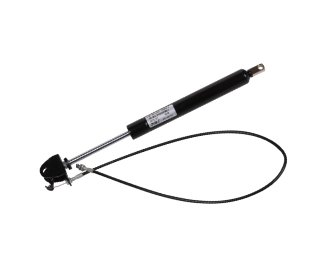If you are interested in our products ,please contact our team
While most people hear the term "spring," they picture a coil of metal that can retract whilst under pressure and then rebound back to its original position when the tension is reduced.
Although this is a popular design for springs, it does not apply to all springs.
There are numerous forms of springs, the most popular of which are mechanical or metal springs and gas struts.
So, just how do mechanical springs and gas springs vary from one another, and which is the most preferable?
While gas struts and metal springs provide essentially the same functions, their principles and applications are different.
In this post, we will quickly examine the mechanics of their action and explain when struts or springs should be used.

Metal springs can store mechanical energy based on the elastic deformation of the metallic structure.
They absorb and reduce shocks while maintaining pressure distribution. They are used to link two or more parts flexibly.
Their downside is that mechanical energy accumulates in the metal spring, which is often not desired.
As a result, the spring contracts or stretches rather more but does not quickly return to its original position. Vibrations follow as a result.
Gas struts come in three varieties: locking, compression, and traction. An inserting piston rod into a cylinder characterizes each type.
Nitrogen is pumped into the cylinder. With a compression or traction strut, the piston rod enters or exits the cylinder by sliding in or out, respectively.
In turn, this causes the pressure to rise and the operational volume of nitrogen to decrease.
When this pressure is applied to the piston rod's plunger, a force is formed that progressively propels the piston rod out of the cylinder.
However, in a traction strut, the piston rod is typically pulled back within the cylinder.
The benefit of gas struts is that the force gradually increases while sliding in or out.
When a metal spring is released, all of its accumulated energy is expended instantaneously.
Furthermore, the struts may be secured in a certain orientation, which is virtually impossible when deploying a metal spring.
As a result, they are employed in conditions where there is an excessively quick change in tension, such as when a spring is required for a vehicle suspension system.
In comparison to metal springs, gas struts can absorb and exert greater energy.
Though smaller gas struts provide little energy, the bigger gas strut employed in the production industry may produce up to 40 metric tons of pressure.
It is indeed worth noting that our gas struts have a degressive construction, which means they apply greater force as the cylinder expands.
Gas struts are adaptable, allowing manufacturers to select their desired output force, couplings, as well as other accessories.
Metal springs do not often provide this amount of adjustability. Consequently, manufacturers are limited to selecting from a limited basic mechanical spring configuration.
Your safety is extremely important to us since, as specialized gas strut manufacturers, we always make sure that all of our products are of the greatest calibre and can resist any challenging situation.
Kindly get in contact with us right away if you have any questions regarding the products and services we can provide you; we'll be pleased to help.